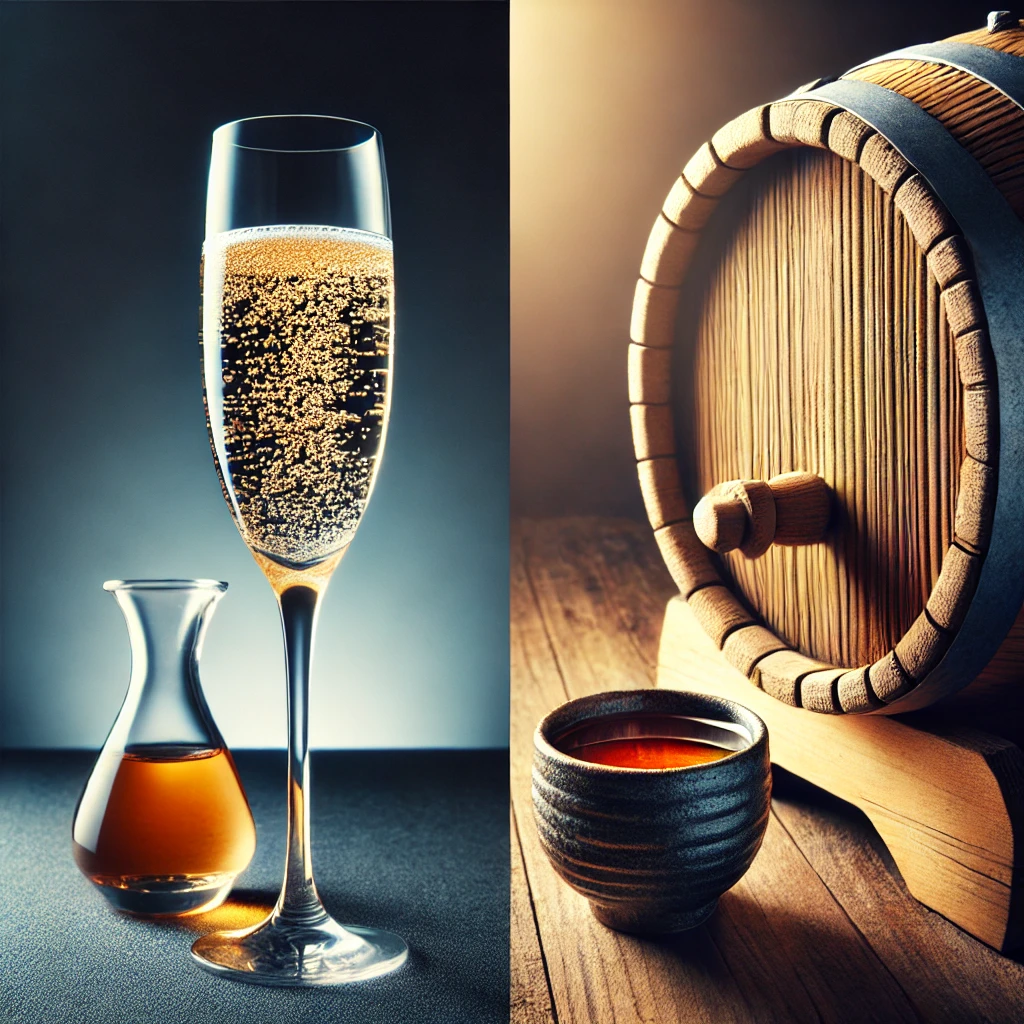Hello, it’s Mana! While studying for the Sake Certification, I discovered that there are not only traditional methods but also a wide variety of brewing techniques. In this post, I’ll introduce some particularly interesting ones, such as ‘Sparkling Sake,’ ‘Aged Sake,’ and those made with ‘Barrel Brewing’—each crafted with unique methods.
1. Sparkling Sake – A New Way to Enjoy Sake
First off, let’s talk about Sparkling Sake. As the name suggests, this is a type of sake that is effervescent, similar to champagne. It has been gaining popularity especially among women and younger generations recently.
There are several methods to produce Sparkling Sake. The most common is secondary fermentation in the bottle, which creates carbonation in the same way as champagne. There are various types from high alcohol content to sweet and lightly cloudy versions.
There is also a type of Sparkling Sake where carbon dioxide is injected, offering a crisp taste that makes it popular as an aperitif. It’s fun to choose the right type for the occasion.
2. Barrel Brewing – Revival of Tradition
Next, let’s talk about sake brewed in wooden barrels. Traditionally, wooden barrels were used for brewing the mash in sake making, but nowadays stainless steel tanks are mainstream. However, there has been a movement to revive this traditional method in recent years.
Sake brewed in wooden barrels has a subtle wood aroma and a classic taste. The material of the wood influences the mash, creating a unique depth of flavor. This method, which evokes harmony with nature, could be said to represent the origins of sake.
However, wooden barrels are difficult to maintain and prone to leaking, which means that sake brewed this way is often produced in limited quantities and is highly valued.
3. Aged Sake – Rich Flavors Developed Over Time
Aged Sake, also known as aged liquor, is a type of sake that is stored for a long period before shipping. It’s easy to understand if you think of it like vintage wine.
The charm of aged sake lies in its rich aroma and mellow taste. You can enjoy changes that aren’t found in fresh sake due to aging. The color deepens over the years, turning yellow or brown, and a distinctive sweet aroma develops. These changes are irresistible to sake enthusiasts.
However, there is no strict age requirement for what constitutes aged sake; some breweries consider a sake aged if it’s one year old, while others might age their sake for over a decade. This reflects the unique personality of each brewery.
4. Kijoshu – Sake with Noble Sweetness
Kijoshu is a type of sake known for its particularly rich sweetness. Unlike typical sake production that uses water to mix with the mash, kijoshu involves a luxurious method where some of the water is replaced with sake. This creates a rich and lusciously sweet flavor.
As a result, kijoshu often serves a role similar to that of a dessert wine, and it is recommended to be enjoyed slowly after a meal.
5. Bodaimoto – A Traditional Technique from the Muromachi Period
Finally, let’s introduce the Bodaimoto method. This is a method of creating the yeast starter that originated in the Muromachi period at the Bodaiji Temple in Nara Prefecture. Nowadays, some breweries have revived this method.
Bodaimoto involves a process where porridge-like rice is dissolved in water, promoting natural lactic acid fermentation. This helps to cultivate the yeast starter while suppressing the growth of unwanted bacteria.
The sake produced with this method is characterized by its acidity and rich flavor. It’s perfect for those who want to enjoy a taste of tradition, handed down from ancient times.
Conclusion
What do you think? I hope you now have a better understanding of the diverse brewing methods of sake, including sparkling sake, barrel brewing, aged sake, kijoshu, and bodaimoto. Knowing about these different methods enhances your enjoyment of sake, allowing you to appreciate the backstory while you drink.
Next time you choose a sake, consider these methods and find your own special bottle.



コメント